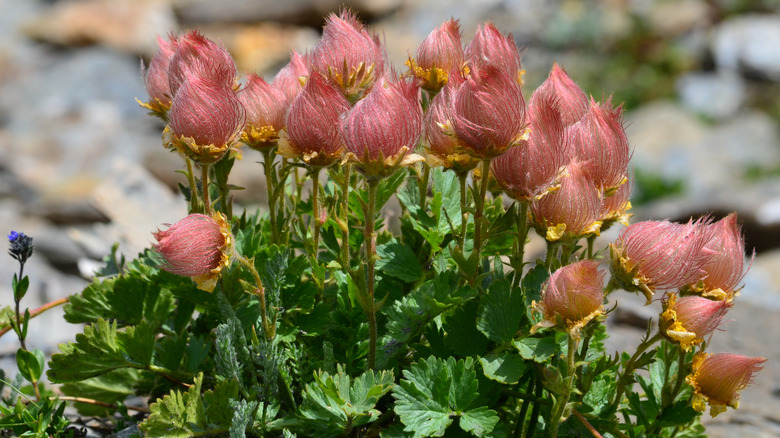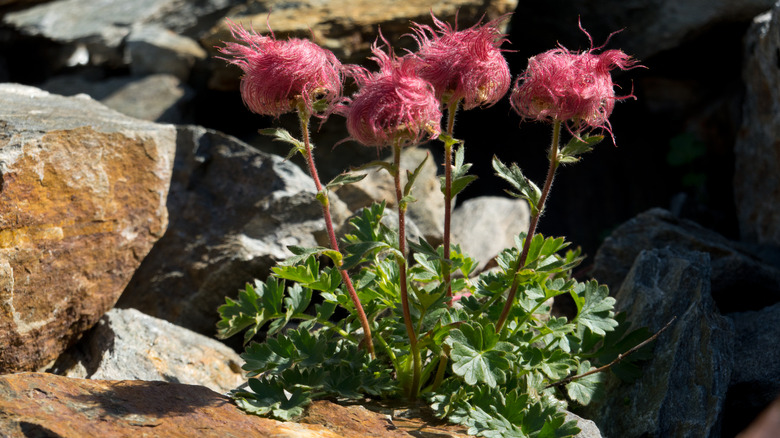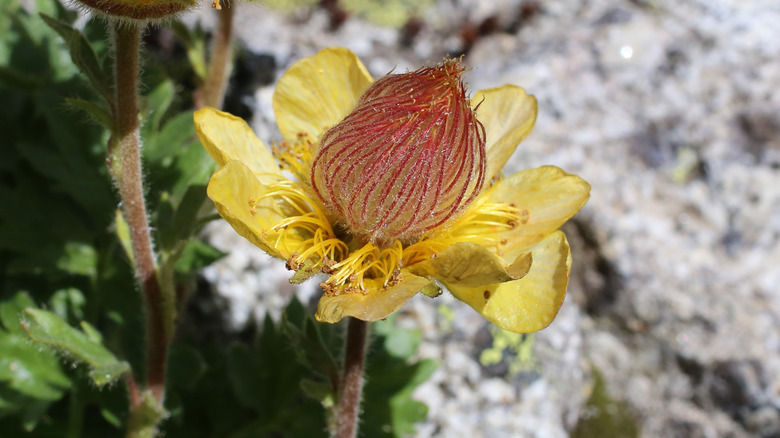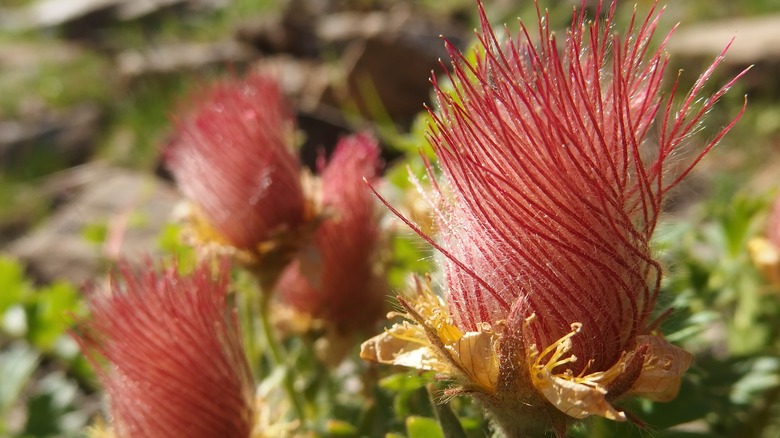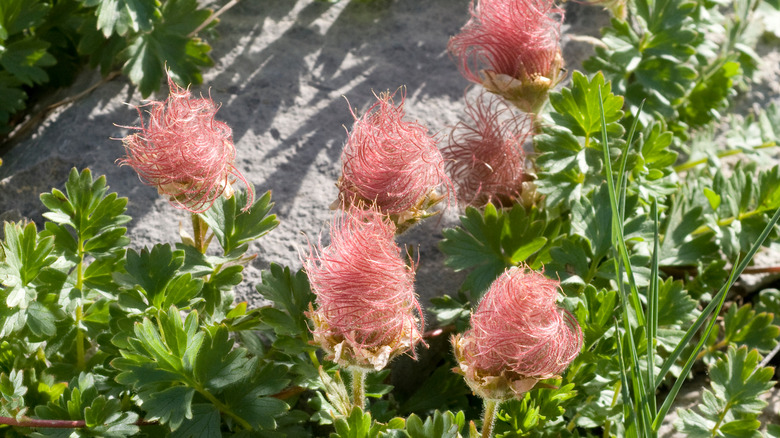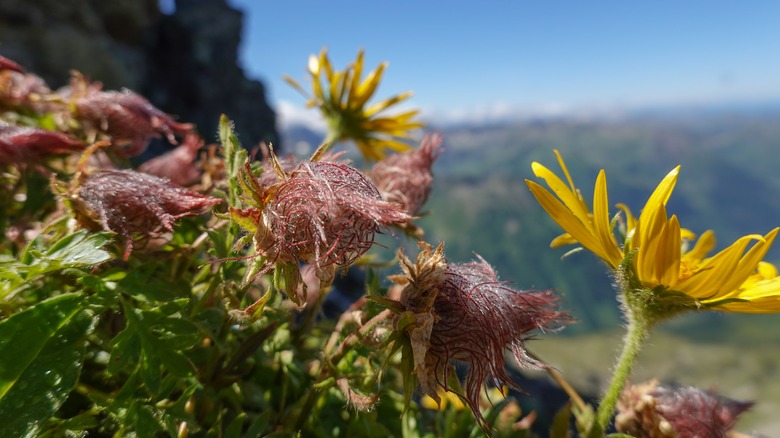How To Grow And Take Care Of Creeping Avens
Native to the mountains of Central Asia and Europe, creeping avens (Sieversia reptans), or geum reptans, are unique-looking perennials with blooming bright yellow flowers, which wilt and turn into a dusty rose-colored seed head that resembles a spool of cotton candy. Creeping avens, named for their red runners that resemble those of a strawberry plant (per Gardening Know How), are actually a member of the rose family, Rosaceae. Apart from the beautiful blooms, their leaves are equally charming: They are separated into several tiny leaflets. The plants are either evergreen or deciduous depending on the species and environmental circumstances.
They are hardy plants and relatively easy to care for in various climates — growing in temperatures as low as in the USDA hardiness zone 2, per some sources, but is mainly thriving in zones 4 through 9. This color-changing, whimsical flowering perennial is an excellent flora to have in your garden. In addition, RxList writes that they also have medicinal benefits, treating colitis, fever, and other conditions, which makes them both aesthetically valuable and physically beneficial. Keep reading to learn how to grow and care for creeping aven flowers.
How to use creeping avens in garden
Creeping avens make for a really interesting addition to any garden or yard. According to Masterclass, these perennials grow best in USDA hardiness zones 4 through 8. While they can grow in colder climates, they won't thrive, and they may not grow perennially. Since creeping avens prefer full sun, they shouldn't be grown anywhere hotter, as warmer suns can damage the plant.
Creeping avens grow most commonly as ground cover, natively found along gravelly mountains. While you can grow them in more contained ways, they will look best when allowed to grow in lush, low-lying tufts. Better Homes & Gardens recommends growing it with popular flowers in cottage landscaping, such as bellflowers, daisies, delphiniums, foxgloves, hollyhocks, hydrangeas, coral bells, dame's rockets, and dianthus. They also recommend planting creeping avens in rock gardens. Of course, the rose relative can grow along with other Rosaceae members. Planting the whimsical-shaped flower among a bed of multicolored roses would definitely produce a romantic but playful effect.
How to grow creeping avens
While you can grow creeping avens from seed, Martha Stewart strongly recommends introducing the plant to your garden by getting an established plant. Since most people use it as ground cover, it will not only grow and spread quickly from a pre-grown plant, but it will be easier to estimate where it'll develop and control its spread. In addition, some seeds marked as geums may not specifically be creeping avens either, so growing it from an established plant helps you know exactly what will grow.
According to Gardening Know How, you can also grow creeping avens via propagation. This can be done in a couple of ways, but both are quite viable options. The first option is to take a stem cutting in the late summer. To do this, simply cut off a long stem from the plant with a few nodes for leaf and flower growth, dip the end in rooting hormone, and pot the cutting, keeping it in a sunny location for a few weeks or months until the roots form, when it can be transplanted before the winter. You can also regrow creeping avens by dividing a mature plant. Uproot it and gently separate the roots with clean, sharp shears, replanting the two separate plants. They will quickly reroot and grow back to their original size and then some.
How to care for creeping avens
Even for newer gardeners, caring for creeping avens is not a difficult task. But as with all plants, the best way to care for them is to replicate their natural growing conditions. For creeping avens, that involves keeping them in a mild-tempered, sunny, rocky area. While some sources note that the plant is only hardy to zone 6, others claim it can withstand temperatures as low as zone 2. In any case, the creeping avens plant looks to be short-lived.
If possible, creeping avens should be planted in full sun, recommends Gardening Know How. Creeping avens are quite drought-resistant, so only water them during long hot, and dry weather stretches. They don't require particularly moist conditions, either. Other than that, they only require occasional deadheading to help it produce more blooms and look neater. They can also benefit from being cut back after they're done blooming, which will help them direct more energy into producing new flowers as opposed to maintaining the dying ones.
Varieties of creeping avens
Creeping avens belong to the geum genus, which is a part of the larger Rosaceae family. According to Home Stratosphere, there are quite a few members of the geum genus, all of which are perennial — some evergreen — and mostly all bloom from early in the spring to late in the summer. So here are just a few species of geum to brighten up your garden along with creeping avens:
- Geum 'Double Bloody Mary' — This species of geum is popular for both rock and cottage gardens like its whimsically shaped relative. As the name would suggest, it blooms blood-red flowers.
- Geum 'Fireball' — This fiery orange flowering plant can grow as tall as 30 feet and attracts wildlife like butterflies and hummingbirds.
- Geum 'Mai Tai' — These peach flowers are visually stunning when they first bloom but are even more so when they fade to a soft pink throughout the growing season, one plant being able to bear up to 135 flowers.
- Geum triflorum — Also known as Prairie Smoke, these dusty pink flowers strongly resemble creeping avens in color and shape. The triflorum species, though, as the name suggests, grows in a smoke-like shape, as opposed to the fluffy, whipped look of its relative.
- Geum rivale 'Leonard's Variety' — This species is commonly referred to as Water Avens due to their love of moisture and grows droopy, bell-shaped deep pink flowers.
Are creeping avens toxic?
Creeping avens are not toxic to humans or pets. In fact, the Rosaceae family is generally safe for pets and humans, Plant Care Today notes. The only major concern regarding pets ingesting creeping avens is if they have been treated with harmful chemicals, so still, monitor your pets around the plant. While they are simply non-toxic for pets, they are actually believed to have benefits for humans. Martha Stewart states that the cotton candy-shaped flower is a popular ingredient in traditional Austrian medicine, commonly dried and drank as tea and used to treat ailments including diarrhea, mouth ulcers, gout, infections, and reducing fevers.
That being said, there isn't much hard evidence to back this up, so while it's not dangerous to ingest, proceed with caution. WebMD warns that avens, in general, could potentially be unsafe for pregnant people and possibly throw off menstrual cycles. There is also no scientific evidence on whether avens are safe for those breastfeeding. As with any supplement, it's always best to consult your doctor before use.
How to repot creeping avens
Creeping avens are quick growers, which is why you should uproot and divide the plant every two to three years. This will help you control the growth and result in healthier plants. To divide creeping avens, begin by using a shovel to dig around the plant and gently pull it up from the ground with your hands. Remove as much old dirt as possible, assess the root system, and remove and discard any rotten, old, or mushy roots. If an infection or infestation has taken over your creeping aven, this is a good time to treat it. Then, using a sharp knife or garden shears, cut the plant in half, thirds, or quarters, advises the University of Minnesota.
To replant, start by looking at the planting site. The dirt should be rich, well-draining, and gritty (via Masterclass), so add the appropriate soil amendment if you notice the plant lacks nutrients or drainage. Adding mulch is also a good idea. The hole for the plant should be as deep as the roots, the top roots sitting level with the soil, and twice as wide. Then, simply fill it with dirt and water. This should be done after the plant is done flowering for the season.
